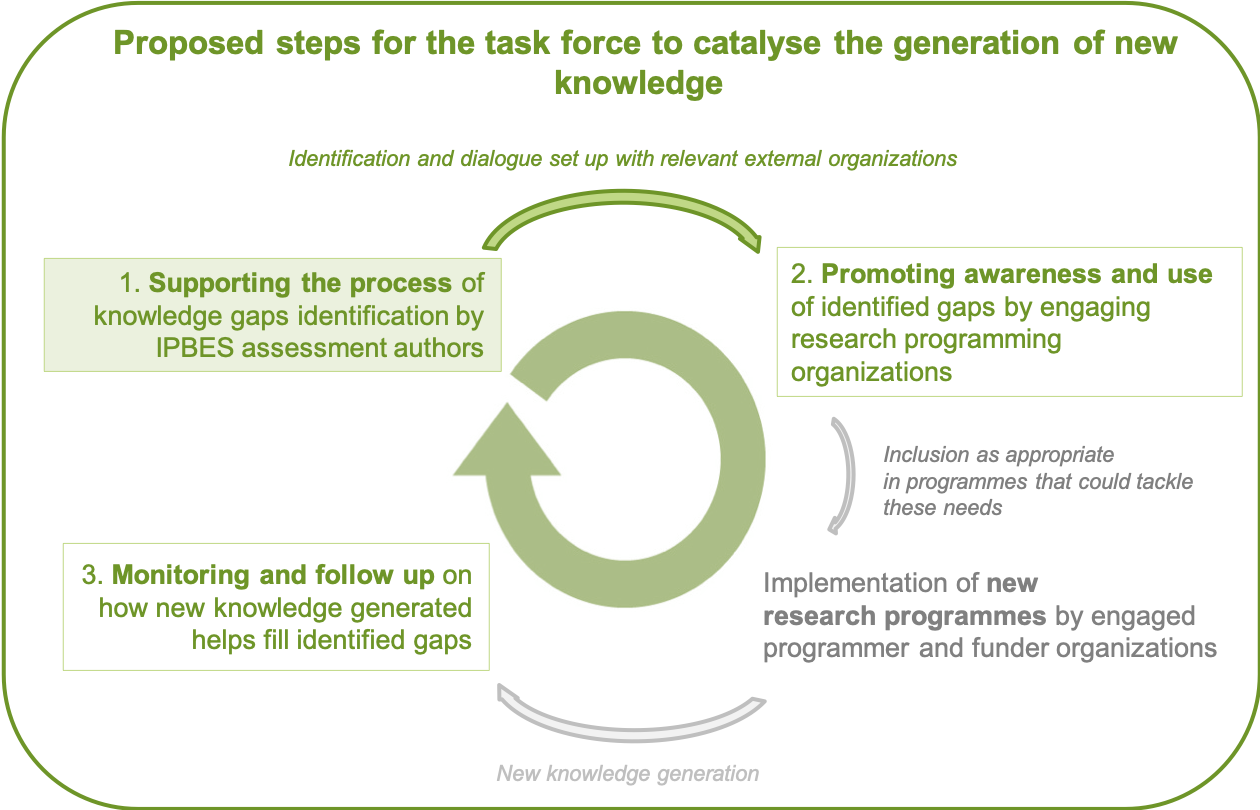Process to catalyse the generation of new knowledge
The process to catalyse the generation of new knowledge consists of three steps summarised in a figure, and detailed below:
- Supporting the identification of knowledge gaps by experts
- Promoting the uptake of identified knowledge gaps by relevant external organizations and initiatives
- Monitoring of gaps’ uptake and how new knowledge generation effectively fills identified gaps

Step 1. Supporting the identification of knowledge gaps by experts (including data gaps and Indigenous and local knowledge mobilization gaps)
The task force will support assessment authors by proposing guidance material and an updated template for efficient identification of knowledge gaps (including in relation to data gaps and Indigenous and local knowledge mobilization gaps) in each assessment. This is implemented throughout the production of each IPBES assessment, and in particular at or close to the three author meetings, as follows:
1st author meeting
brief presentation highlighting why the collection of knowledge gaps is important and providing materials to assessment experts, including:
- the guidelines on how to identify these gaps, explaining the expectations and process regarding knowledge gaps identification during the assessment: key steps for IPBES experts (co-chairs, coordinating lead authors, lead authors and fellows) during the assessment cycle,
- possible formats for knowledge gaps and related sections in assessments; and
- examples of good and poor practices;
If there is not enough time at the 1st author meeting to present these items in detail, a session could be organised between the 1st and 2nd author meetings.
2nd author meeting
session to further guide the identification of knowledge gaps by assessment experts, in line with the guidance made available, for the development of future drafts (especially the second drafts of the chapters);
3rd author meeting
session on knowledge gaps to assess outcomes of the identification process, refine knowledge gaps with authors as relevant, and support the assembly of a consolidated list for the assessment as relevant.
Step 2. Promoting the uptake of identified knowledge gaps by relevant external organizations and initiatives
The task force elaborates and implements a process for promoting the uptake of gaps identified in IPBES assessments. It focuses its engagement on external organizations that specialize in research programming and in funding the generation of new knowledge.
The task force facilitates the organization of dialogues between experts of IPBES assessments and relevant external organizations and institutions, primarily programmers and funders involved in new knowledge generation. Work includes:
- Mapping relevant external organizations and initiatives that programme and fund new knowledge generation, in particular at regional/sub-regional levels;
- Organizing several (e-)conferences presenting newly identified knowledge gaps;
The task force will seek opportunities to hold physical rather than virtual dialogues, e.g. back-to-back with meetings attended or organized by relevant external organizations, to help ensure efficiency and avoid duplication of engagement efforts.
Step 3. Monitoring gaps’ uptake and how new knowledge generation effectively fills identified gaps
The task force monitors the extent to which programmes implemented by external organizations and institutions for the generation of new knowledge explicitly identify gaps highlighted in IPBES assessments and contribute to filling these gaps. This is achieved through the development and implementation of a monitoring plan which includes key performance indicators on the uptake of gaps by external organizations (e.g. number of uptakes or references to IPBES knowledge gaps following dialogue events with programmers and funders; number of projects / funding amount invested by programmes that address knowledge gaps identified by IPBES), and on how this contributes to filling these gaps.